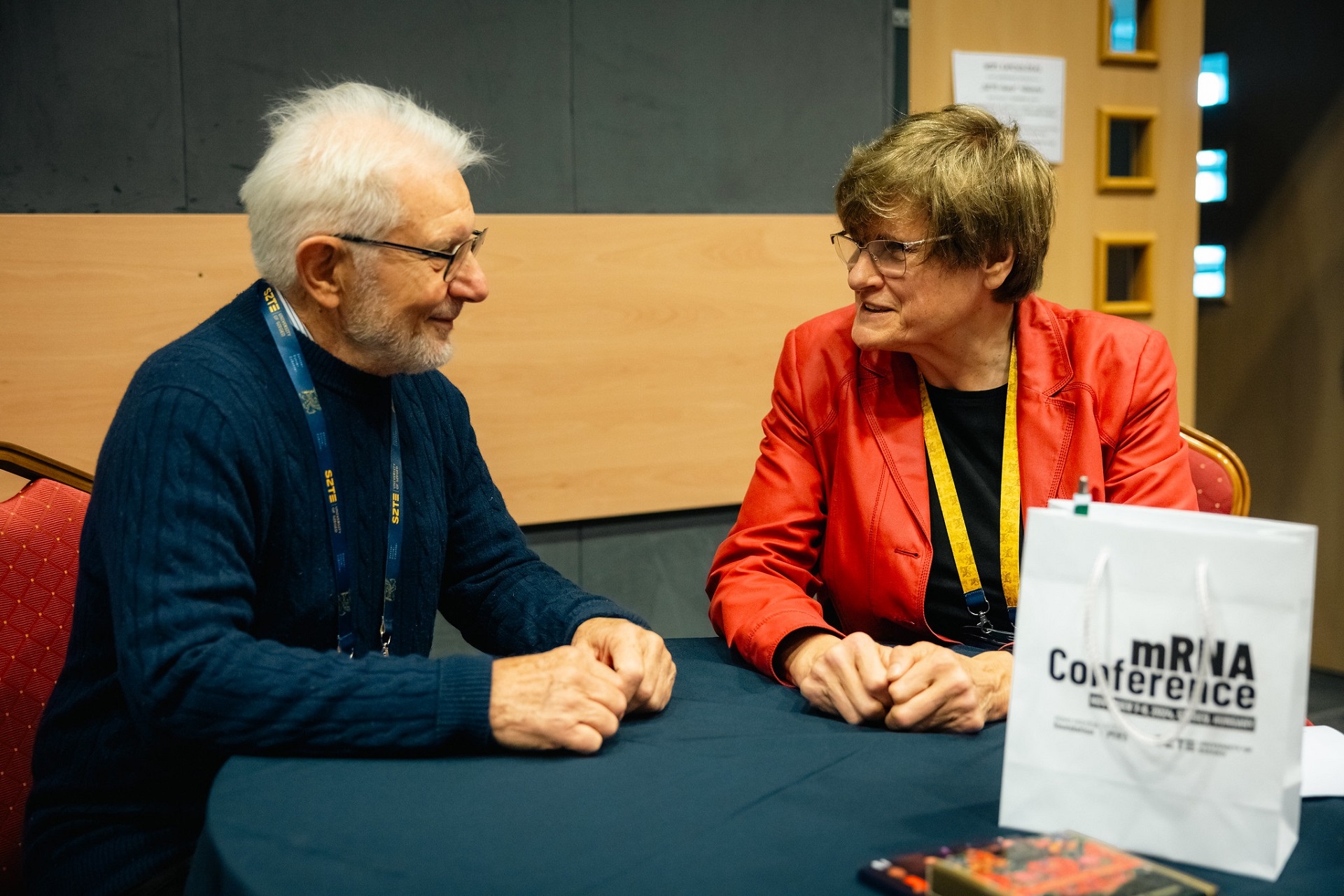
The “most fragile molecule” took center stage at the 2024 mRNA Conference in Szeged, one of the year’s most prestigious scientific gatherings. To reflect on the symposium and its impact, we spoke with Ernő Duda, retired professor from the University of Szeged’s Albert Szent-Györgyi Medical School and senior session chair at the international event. This interview concludes our series, “Highlights from the Szeged mRNA Conference”.
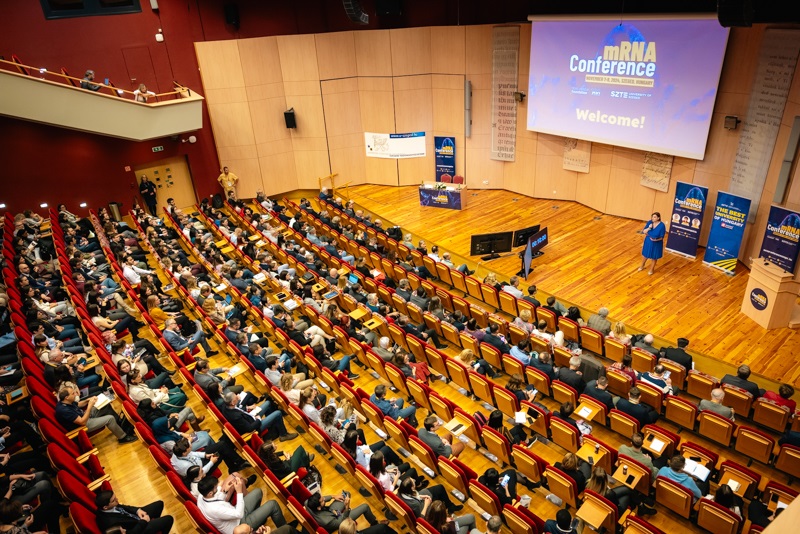
Q: Hosted by the University of Szeged and funded by the Novo Nordisk Foundation, the mRNA Conference in Szeged took place on November 7–8, 2024, featuring a presentation lineup curated by Katalin Karikó, the University of Szeged’s Nobel Prize-winning professor. Our “Highlights from the mRNA Conference” series has already covered key topics with articles titled “mRNA: More Applications than Limitations” and “Healing as the Ultimate Goal of Research Efforts.” As we conclude the series, we’d like to hear your thoughts on what you consider to be the key takeaways from the conference.
A: A recurring theme throughout the presentations was the utilization of non-inflammatory, nucleoside-modified messenger RNA (mRNA). While mRNA’s effectiveness in vaccines is well established, this conference highlighted its potential in other groundbreaking applications. In essence, an entirely new field of science has emerged, offering possibilities for the treatment of a wide range of diseases.
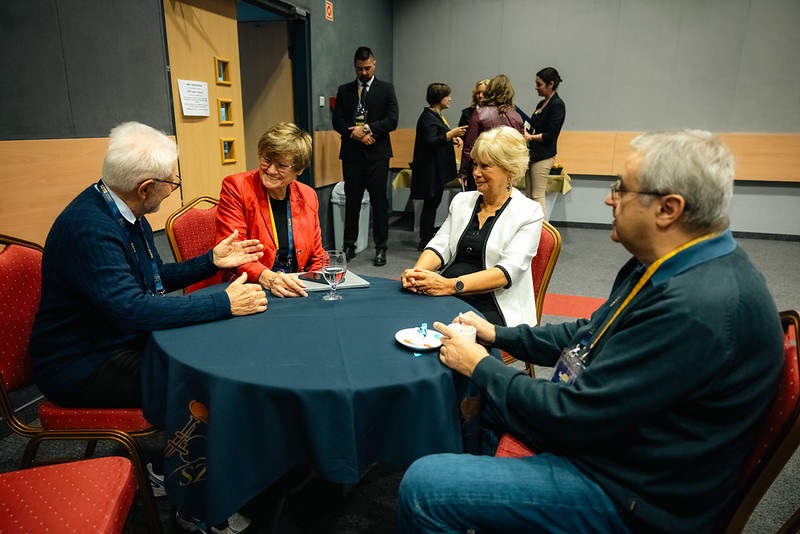
Former colleagues from the Szeged Biological Research Center, Ernő Duda, Katalin Karikó, Éva Kondorosi, and Tamás Kiss (pictured from left to right), remain connected through their work as researchers. During breaks at the mRNA Conference, they reminisced about their shared past and discussed the future.
Photo by István Sahin-Tóth
Q: The conference brought together a diverse group of experts, including biologists, biochemists, chemists, and medical researchers, who shared their groundbreaking findings. But how does progress in one area spark innovation in another?
A: The emergence of this entire field of science was catalyzed by the trailblazing efforts of the Karikó–Weissman research duo, who developed a method to introduce messenger RNA (mRNA) into cells without triggering an inflammatory response. This breakthrough opened the door to a world of possibilities, for instance, in replacing missing proteins, repairing faulty genes, developing vaccines, and driving other therapeutic innovations.
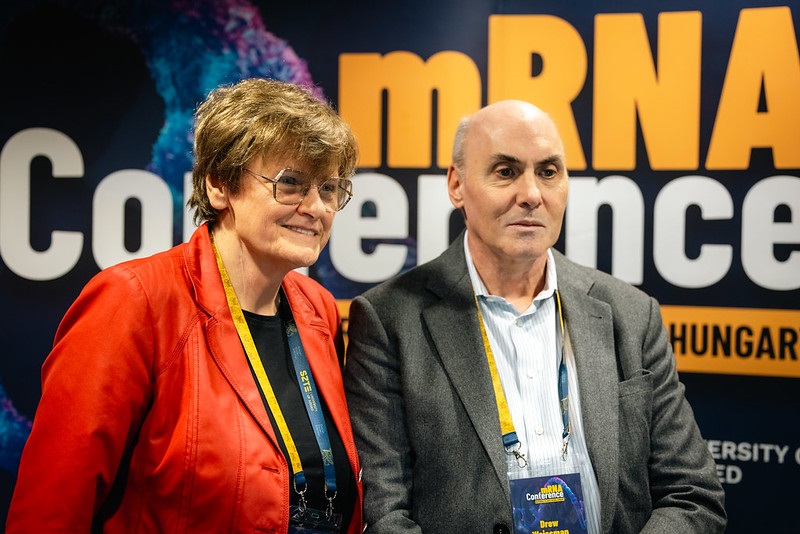
Nobel laureates Katalin Karikó and Drew Weissman outlined the future of mRNA technology at a press conference, where they also addressed key scientific topics and shared personal anecdotes.
Photo by István Sahin-Tóth
Q: Remarkably, four of the fifteen speakers featured at the conference are alumni of the University of Szeged or its predecessor, József Attila University. Among them is Katalin Karikó, the University’s Nobel Prize-winning professor. Her mentee, Norbert Pardi, now runs his own lab at the University of Pennsylvania. Furthermore, Tamás Kiss, who once provided Karikó with valuable advice drawing on their collaboration at the Biological Research Center in Szeged, is now a professor at the University of Toulouse. Meanwhile, Antal Nógrádi, a professor at the University of Szeged’s Albert Szent-Györgyi Medical School, conducts pioneering research supported in part by funds generously donated by Professor Karikó from her award winnings. What role did these four researchers with ties to the University of Szeged play at the international mRNA conference?
A: The presentation delivered by Tamás Kiss explored the myriad ways in which nature alters nucleic acid structures – modifications closely tied to Katalin Karikó’s groundbreaking discoveries. These natural modifications to macromolecules enable the body to distinguish its own RNA from foreign, potentially harmful molecules, such as those derived from viruses. Similarly, therapeutic mRNA must be carefully modified to avoid triggering an inflammatory response, as it is foreign to the cell. Professor Karikó’s genius lay in identifying the precise modifications needed to harness mRNA for therapeutic purposes. In her talk, she traced the process of these discoveries and their transformation into groundbreaking advancements in modern medicine.
Focusing on vaccines and protection against emerging pathogens, Norbert Pardi offered insights into cutting-edge developments. Likewise, Antal Nógrádi’s presentation looked to the future, highlighting the groundbreaking potential of RNA therapy for rehabilitating individuals paralyzed by spinal cord injuries.
It’s worth noting that mRNA-based research in Hungary is still in its early stages. For researchers venturing into uncharted territory, the path is often arduous, with meaningful results typically requiring months of persistent effort. Against this backdrop, Nógrádi’s presentation was particularly intriguing, showcasing tangible achievements accomplished within a remarkably short period of time.
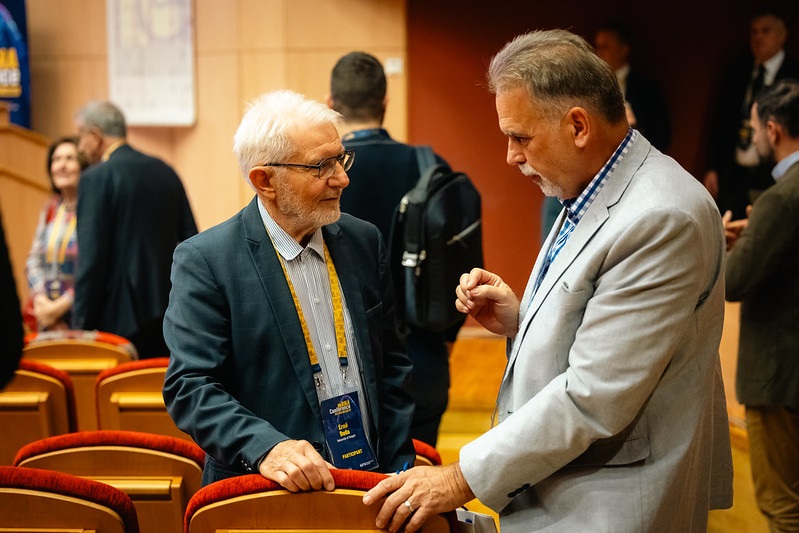
Professors in conversation: During a break at the international mRNA conference, session chair Ernő Duda (left) and speaker Antal Nógrádi engaged in a lively discussion.
Q: During her presentation, Katalin Karikó noted that she regarded you as a particularly inventive researcher during your time at the Biological Research Center in Szeged. Could you elaborate on your personal connection to the mRNA conference?
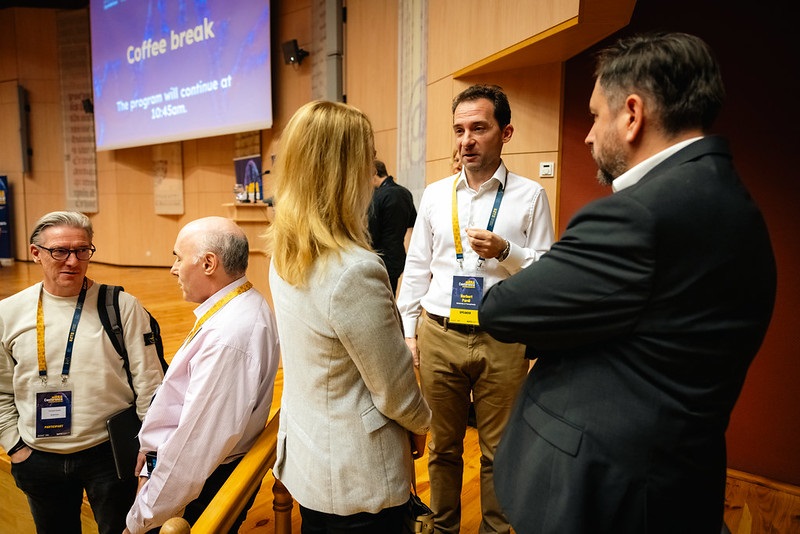
Coffee break at the mRNA Conference in Szeged: Following the presentations in the University of Szeged Congress Center’s grand hall, attendees eagerly addressed additional questions to the speakers, including Drew Weissman (second from left) and Norbert Pardi (second from right).
Photo by István Sahin-Tóth
Q: Norbert Pardi and his collaborators focus on mRNA encapsulated in lipid nanoparticles. Could you explain how these nanoparticles enhance the effectiveness of mRNA?
A: Lipid nanoparticles are crucial for the functionality of mRNA vaccines. As one of the most fragile molecules, mRNA would be rapidly degraded by enzymes if not enclosed within these nanoparticles. The larger the RNA molecule, the greater its vulnerability – and messenger RNA is among the largest, making it particularly prone to these vulnerabilities. This “protective shell” not only shields mRNA from degradation but also ensures its successful delivery into living cells, which would otherwise be impossible due to its immediate breakdown.
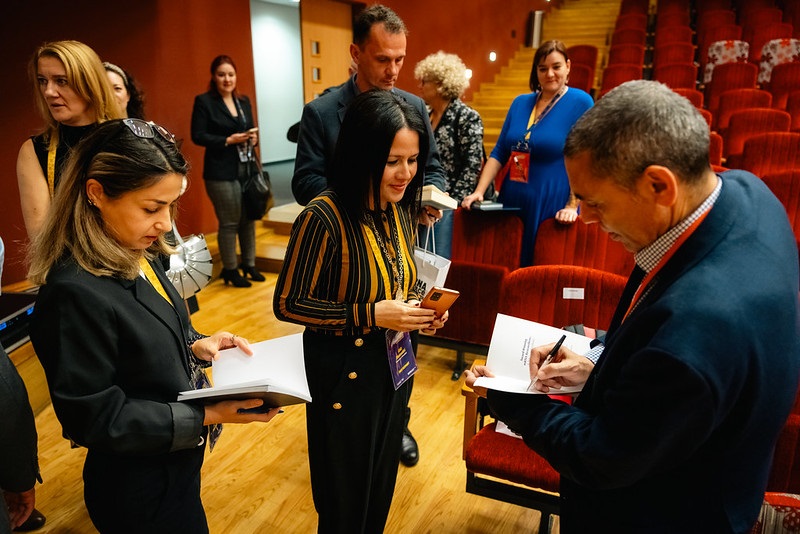
Star researcher Uğur Şahin from Mainz signed many autographs during breaks at the mRNA Conference.
Photo by István Sahin-Tóth
Q: Uğur Şahin, a keynote speaker at the symposium, research partner of the Nobel Prize-winning Karikó–Weissman duo, and recipient of the Novo Nordisk Prize, not only captivated audiences with his presentation but also actively engaged with other speakers, posing insightful questions following their talks. Would you agree that one of the standout features of the Szeged mRNA Conference was the way each presentation inspired numerous questions?
A: The audience was remarkably diverse, and I was pleased to see many university students participating alongside prominent representatives from the field. This diversity resulted in a fascinating mix of questions – some delving deeply into highly specialized scientific details, others seeking to clarify concepts for less experienced attendees, such as the students. The wide range of inquiries underscored the broad and growing interest in the topic.
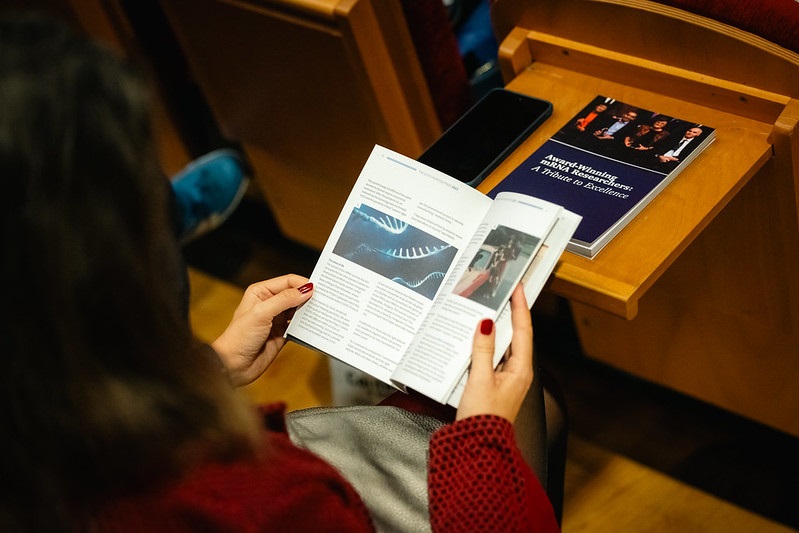
Attendees eagerly sought autographs, not only on copies of Katalin Karikó’s memoir, Breaking Through: My Life in Science, but also on a special publication celebrating the joint awards of the four Novo Nordisk Prize-winning scientists: Özlem Türeci, Uğur Şahin, Katalin Karikó, and Drew Weissman.
Q: Members of the audience were treated to a stunning display of the solid gold Nobel plaques of Albert Szent-Györgyi and Katalin Karikó in the Klebelsberg Library’s exhibition space at the University of Szeged. Conference participants also received commemorative medals featuring the portraits of the university’s two Nobel Prize-winning professors, along with a publication celebrating the joint awards of the four Novo Nordisk Prize honorees—Karikó, Weissman, Şahin, and Türeci. Both the conference gifts and the engaging conversations during the breaks played a key role in helping attendees forge connections with the speakers. In terms of atmosphere, how does the Szeged mRNA Conference compare to other international conferences you’ve attended?
A: We had the privilege of attending an exceptionally well-organized conference in Szeged, where everything ran so smoothly that it was truly outstanding. One of the standout features was the innovative approach of having each session co-led by a senior researcher alongside a young researcher from the University of Szeged. This initiative proved to be brilliant. So, special commendation is due to the organizers, led by Professor Attila Gácser, head of the Institute of Biology at the University of Szeged, for bringing this outstanding idea to life. The young researchers involved should also be praised for their remarkable professionalism and expertise, which exceeded my expectations.
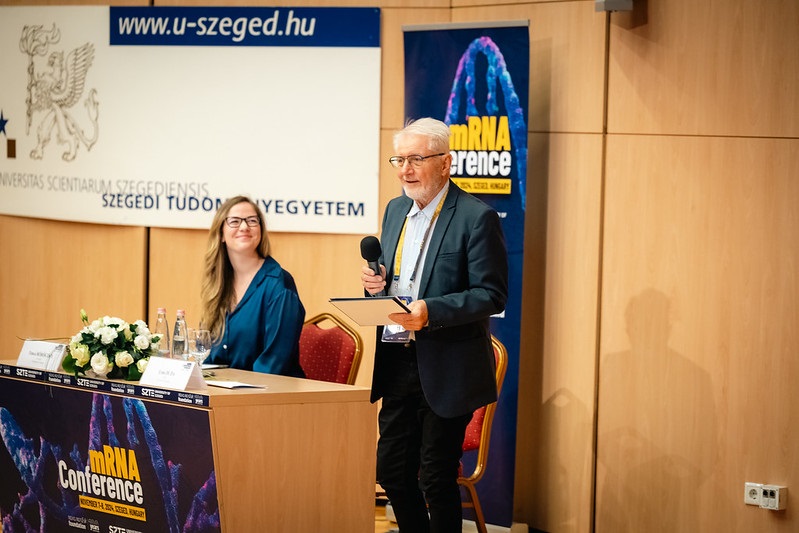
In the session chaired by Tímea Böröczky and Ernő Duda, insightful presentations were delivered by Gerald Schwank, Zoltán Jakus, and Katalin Karikó.
Q: What benefits could young researchers, as well as University of Szeged students, gain from this conference?
A: One of the key features and benefits of conferences is that they allow us to learn about results that have yet to be published, providing an early glimpse into these findings and the current state of science. Another important element of these international events, particularly for young researchers, is the chance to explore potential career prospects. These conferences often function as ‘career fairs,’ where senior scientists can scout potential trainees, and young researchers can approach speakers whose presentations they’ve attended, exploring opportunities for collaboration. While this dynamic was somewhat less pronounced at the Szeged conference compared to other international gatherings, I’m hopeful that many students took the chance to connect with these distinguished researchers and discuss potential future collaborations.
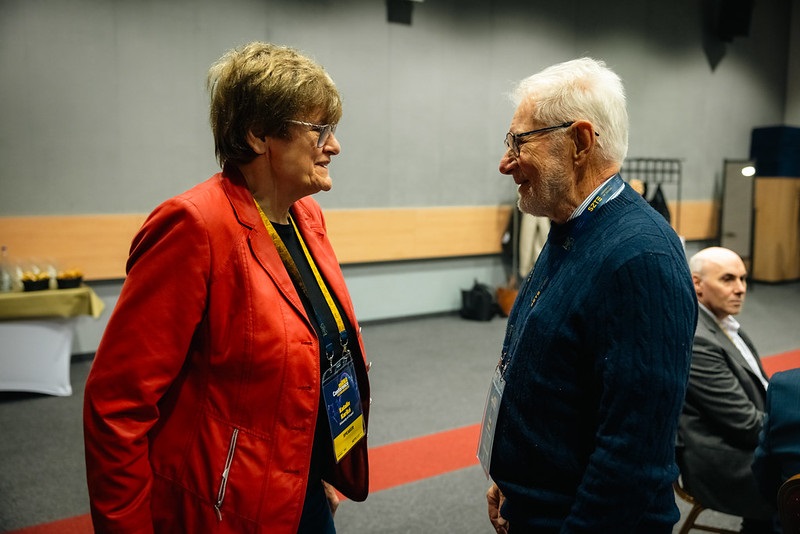
Professor Ernő Duda believes that the world’s top mRNA researchers were drawn to the Szeged conference by the compelling invitation of Nobel laureate Katalin Karikó.
Photo by István Sahin-Tóth.
Q: What sets this conference apart from similar events at Western universities?
A: At a prestigious Western European university, it’s common for one or two world-renowned guest speakers to present every week, sharing their expertise on key topics, the latest advancements, and groundbreaking discoveries. Unfortunately, this level of engagement has been rare in Szeged, making the mRNA Conference a unique opportunity to hear from distinguished speakers who are leaders in their fields. It would be wonderful to see top-tier speakers from both America and Europe extending their journeys beyond the usual stops in Vienna, Prague, or Budapest, all the way to Szeged. While this idea may seem idealistic, we are committed to doing everything possible to bring the world’s leading researchers and speakers to the University of Szeged.
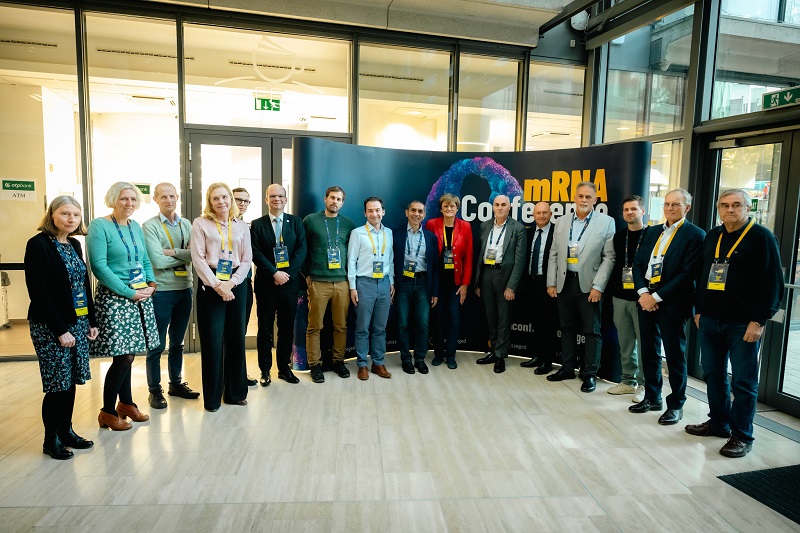
Over 550 participants attended the mRNA Conference in Szeged, with its speakers playing a pivotal role not only in advancing science but also in making it accessible and engaging to the public. The photo features the conference speakers, from left to right: Persephone Borrow, Katrien Remaut, Robin Shattock, Karin Loré, Nicolas Manel, Zoltán Jakus, Gerald Schwank, Norbert Pardi, Uğur Şahin, Katalin Karikó, Drew Weissman, Martin Ridderstråle, Antal Nógrádi, Rein Verbeke, Jørgen Frøkiær, and Tamás Kiss.
Photo by István Sahin-Tóth
Q: Amid the extensive media coverage of the rise of deepfake videos generated by artificial intelligence (AI), the mRNA Conference in Szeged still garnered significant media attention during Hungary’s Month of Science. Why is it essential to raise public awareness about this small but impactful field of science?
A: One of the great challenges of the 21st century is dealing with pseudoscience, particularly the spread of fake news and misinformation, often backed by certain states and interest groups. Sadly, this also impacts science. What we see is that individuals drawn to sensational headlines on the internet and willing to accept even the most absurd claims at face value often resist engaging with authentic science and exploring genuine findings – despite our best efforts. While it may seem like a quixotic struggle, we must actively fight against fake news. If we remain passive, we essentially allow those spreading nonsense to shape the playing field. In this context, the Szeged mRNA Conference and its media coverage can play a crucial role in convincing the public that the ultimate goal of this research is nothing less than healing.
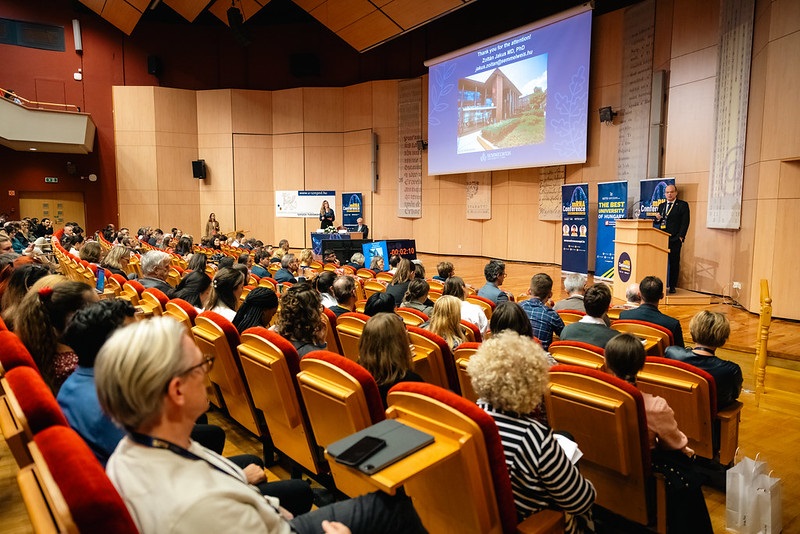
Original Hungarian text by Ilona Újszászi
Photos by Ádám Kovács-Jerney and István Sahin-Tóth
Previous articles on the mRNA Conference in Szeged (published both before and after the event):
Scripting the Narrative of Life: Geneticist Dr. Tamás Kiss Shares Insights into the Once-Hidden World of Small RNAs
Stem Cells Reveal Secret to Beneficial Proteins for mRNA Therapy - An Interview with Neuroscientist Prof. Dr. Antal Nógrádi
mRNA: More Applications than Limitations - Highlights from the mRNA Conference
“Our thirst for knowledge drives us; we have discussions even at three in the morning.” – Press conference with Katalin Karikó and Drew Weissman
Szeged in the global spotlight as mRNA Conference kicks off
Countdown to the mRNA Conference: University of Szeged rolls out the red carpet
Beyond Vaccines: Dive into the World of mRNA with Coursera’s Latest Course
Fueling innovation: Why Novo Nordisk is backing the Szeged mRNA Conference
A real eye-opener: Coursera’s free course on mRNA
Groundbreaking mRNA research at the University of Szeged: New research center to drive future mRNA innovations
New advances in mRNA research spark hope – one year after Katalin Karikó’s Nobel Prize win
Just One Month to Go: Top-Tier Summit of the Scientific Scene Featuring Katalin Karikó at the University of Szeged
Ordinary days in the extraordinary life of a Nobel laureate: Katalin Karikó talks about a park bench in Philadelphia and mRNA researchers
University of Szeged to host two-day conference on the ‘Swiss Army knife’ of medical science

